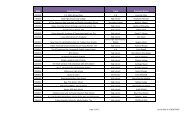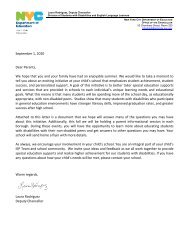282T. Charman et al.Future studies should build on such advances <strong>in</strong> order to study how different aspectsof social-communication ability measured <strong>in</strong> <strong>in</strong>fants <strong>with</strong> <strong>autism</strong> spectrum disorderrelate to later <strong>language</strong> <strong>and</strong> social <strong>outcome</strong>s. Although the practical obstaclesto such studies are considerable, sample sizes should be sufficient to conductanalyses that look at the <strong>in</strong>dependent contributions of diagnosis <strong>and</strong> earlysocial-communication ability that was not possible <strong>with</strong> the present sample.ConclusionsThe present f<strong>in</strong>d<strong>in</strong>gs add to our underst<strong>and</strong><strong>in</strong>g of social-communicative competence<strong>in</strong> young children <strong>with</strong> <strong>autism</strong>. Confirm<strong>in</strong>g the majority of previous work, bothjo<strong>in</strong>t attention <strong>and</strong> imitation were longitud<strong>in</strong>al predictors of later <strong>language</strong> ability,although <strong>in</strong> contrast to other studies, measures of play behaviour were not—although this may be due to floor effects.Not<strong>with</strong>st<strong>and</strong><strong>in</strong>g the gaps that rema<strong>in</strong> <strong>in</strong> our knowledge, the present studydemonstrated that early social-communication skills can be measured <strong>in</strong> <strong>in</strong>fants<strong>with</strong> <strong>autism</strong> spectrum disorder. In cl<strong>in</strong>ical assessments of 2- <strong>and</strong> 3-year olds <strong>with</strong><strong>autism</strong>, many of whom may have little if any <strong>language</strong> ability, the assessment ofthese early social-communication abilities may provide important prognostic <strong>in</strong>dicators.Fortunately, several st<strong>and</strong>ardized <strong>in</strong>struments, <strong>in</strong>clud<strong>in</strong>g the ESCS (Seibertet al. 1982) <strong>and</strong> ADOS (Lord et al. 1999, 2000), are available to aid <strong>in</strong> this process(Baird et al. 2001, Charman <strong>and</strong> Baird 2002 for reviews).Furthermore, it is widely agreed that non-verbal social-communicative behaviourssuch as jo<strong>in</strong>t attention, imitation <strong>and</strong> play are an appropriate target for<strong>in</strong>tervention efforts (Dawson <strong>and</strong> Galpert 1990, Bondy <strong>and</strong> Frost 1995, Rogers1998, Drew et al. 2002). There is also evidence that experimental manipulation <strong>and</strong>even <strong>in</strong>dividual differences <strong>in</strong> adults’ social responsiveness to a child <strong>with</strong> <strong>autism</strong><strong>in</strong> turn affects their social <strong>in</strong>teraction (Lewy <strong>and</strong> Dawson 1992, Knott et al. 1995,Willemsen-Sw<strong>in</strong>kels et al. 1997, Siller <strong>and</strong> Sigman 2002). It is <strong>in</strong>creas<strong>in</strong>gly clear thatsocial-communication behaviours that emerge typically <strong>in</strong> <strong>in</strong>fancy are related tolater <strong>language</strong> <strong>and</strong> social <strong>outcome</strong>s <strong>in</strong> <strong>in</strong>dividuals <strong>with</strong> <strong>autism</strong>. We need to ref<strong>in</strong>eboth the measurement <strong>and</strong> the def<strong>in</strong>ition of these abilities <strong>and</strong> adopt longitud<strong>in</strong>al<strong>and</strong> controlled treatment designs to underst<strong>and</strong> what the mechanism of associationto later <strong>language</strong> <strong>and</strong> social <strong>outcome</strong>s might be. This will allow us to underst<strong>and</strong>better the course, <strong>and</strong> develop strategies to ameliorate the effects, of the underly<strong>in</strong>gpsychopathology that characterizes <strong>autism</strong>.AcknowledgementsTwo MRC Project Grants to S.B.C., A.C. <strong>and</strong> G.B. (1992–96) supported thisresearch. The authors are very grateful to all the families who took part <strong>in</strong> the study<strong>and</strong> to the late Natasha Night<strong>in</strong>gale, <strong>and</strong> to Mary Marden for adm<strong>in</strong>istrative support.ReferencesBAIRD, G., CHARMAN, T., BARON-COHEN, S., COX, A., SWETTENHAM, J., WHEELWRIGHT, S. <strong>and</strong>DREW, A., 2000, A screen<strong>in</strong>g <strong>in</strong>strument for <strong>autism</strong> at 18 month of age: a six-year follow-upstudy. Journal of the American Academy of Child <strong>and</strong> Adolescent Psychiatry, 39, 694–702.BAIRD, G., CHARMAN, T., COX, A., BARON-COHEN, S., SWETTENHAM, J., WHEELWRIGHT, S. <strong>and</strong>
<strong>Predict<strong>in</strong>g</strong> <strong>language</strong> <strong>outcome</strong> <strong>in</strong> <strong>in</strong>fants <strong>with</strong> <strong>autism</strong> 283DREW, A., 2001, Screen<strong>in</strong>g <strong>and</strong> surveillance for <strong>autism</strong> <strong>and</strong> <strong>pervasive</strong> developmental disorders.Archives of Diseases <strong>in</strong> Childhood, 84, 468–475.BARANEK, G., 1999, Autism dur<strong>in</strong>g <strong>in</strong>fancy: a retrospective analysis of sensory-motor <strong>and</strong> socialbehaviours at 9–12 months of age. Journal of Autism <strong>and</strong> Developmental Disorders, 29, 213–224.BARON-COHEN, S., 1987, Autism <strong>and</strong> symbolic play. British Journal of Developmental Psychology, 5, 139–148.BARON-COHEN, S., COX, A., BAIRD, G., SWETTENHAM, J., NIGHTINGALE, N., MORGAN, K., DREW, A.<strong>and</strong> CHARMAN, T., 1996, Psychological markers of <strong>autism</strong> at 18 months of age <strong>in</strong> a largepopulation. British Journal of Psychiatry, 168, 158–163.BARON-COHEN, S., WHEELWRIGHT, S., COX, A., BAIRD, G., CHARMAN, T., SWETTENHAM, J., DREW, A.<strong>and</strong> DOEHRING, P., 2000, The early identification of <strong>autism</strong>: the Checklist for Autism <strong>in</strong>Toddlers (CHAT). Journal of the Royal Society of Medic<strong>in</strong>e, 93, 521–525.BATES, E., BENIGNI, L., BRETHERTON, I., CAMAIONI, L. <strong>and</strong> VOLTERRA, V., 1979, The Emergence ofSymbols: Cognition <strong>and</strong> Communication <strong>in</strong> Infancy (New York: Academic Press).BATES, E., BRETHERTON, I., SNYDER, L., SHORE, L. <strong>and</strong> VOLTERRA, V., 1980, Gestural <strong>and</strong> vocalsymbols at 13 months. Merrill-Palmer Quarterly, 26, 407–423.BATES, E., THAL, D., WHITESELL, K., FENSON, L. <strong>and</strong> OAKES, L., 1989, Integrat<strong>in</strong>g <strong>language</strong> <strong>and</strong>gesture <strong>in</strong> <strong>in</strong>fancy. Developmental Psychology, 25, 1004–1019.BUTTERWORTH, G. E. <strong>and</strong> ADAMSON-MACEDO, E., 1987, The orig<strong>in</strong>s of po<strong>in</strong>t<strong>in</strong>g: a pilot study. Paperpresented at the Annual Conference of the Developmental Psychology Section of the BritishPsychological Society, September 1987, York, UK.CARPENTER, M., NAGELL, K. <strong>and</strong> TOMASELLO, M., 1998, Social cognition, jo<strong>in</strong>t attention <strong>and</strong> communicativecompetence from 9 to 15 months of age. Monographs of the Society for Research <strong>in</strong> ChildDevelopment, 63, 1–143.CARPENTER, M., PENNINGTON, B. F. <strong>and</strong> ROGERS, S. J., 2002, Interrelations among social-cognitiveskills <strong>in</strong> young children <strong>with</strong> <strong>autism</strong>. Journal of Autism <strong>and</strong> Developmental Disorders, 32, 91–106.CHARMAN, T., 1998, Specify<strong>in</strong>g the nature <strong>and</strong> course of the jo<strong>in</strong>t attention impairment <strong>in</strong> <strong>autism</strong> <strong>in</strong>the preschool years: implications for diagnosis <strong>and</strong> <strong>in</strong>tervention. Autism: The International Journalof Research <strong>and</strong> Practice, 2, 61–79.CHARMAN, T., 2000, Theory of m<strong>in</strong>d <strong>and</strong> the early diagnosis of <strong>autism</strong>. In S. Baron-Cohen, H. Tager-Flusberg <strong>and</strong> D. Cohen (eds), Underst<strong>and</strong><strong>in</strong>g Other M<strong>in</strong>ds: Perspectives from Autism <strong>and</strong> DevelopmentalCognitive Neuroscience, 2nd edn (Oxford: Oxford University Press), pp. 422–441.CHARMAN, T. <strong>and</strong> BAIRD, G., 2002, Practitioner Review: Assessment <strong>and</strong> diagnosis of <strong>autism</strong> spectrumdisorders <strong>in</strong> the pre-school years. Journal of Child Psychology <strong>and</strong> Psychiatry, 43, 289–305.CHARMAN, T. <strong>and</strong> BARON-COHEN, S., 1994, Another look at imitation <strong>in</strong> <strong>autism</strong>. Development <strong>and</strong>Psychopathology, 6, 403–413.CHARMAN, T. <strong>and</strong> BARON-COHEN, S., 1997, Prompted pretend play <strong>in</strong> <strong>autism</strong>. Journal of Autism <strong>and</strong>Developmental Disorders, 27, 325–332.CHARMAN, T., BARON-COHEN, S., SWETTENHAM, J., BAIRD, G., COX, A. <strong>and</strong> DREW, A., 2000, Test<strong>in</strong>gjo<strong>in</strong>t attention, imitation <strong>and</strong> play as <strong>in</strong>fancy precursors to <strong>language</strong> <strong>and</strong> theory of m<strong>in</strong>d.Cognitive Development, 15, 481–498.CHARMAN, T., BARON-COHEN, S., SWETTENHAM, J., COX, A., BAIRD, G. <strong>and</strong> DREW, A., 1998, Anexperimental <strong>in</strong>vestigation of social-cognitive abilities <strong>in</strong> <strong>in</strong>fants <strong>with</strong> <strong>autism</strong>: cl<strong>in</strong>ical implications.Infant Mental Health Journal, 19, 260–275.CHARMAN, T., DREW, A., BAIRD, C. <strong>and</strong> BAIRD, G., 2003, Measur<strong>in</strong>g early <strong>language</strong> development <strong>in</strong>pre-school children <strong>with</strong> <strong>autism</strong> spectrum disorder us<strong>in</strong>g the MacArthur CommunicativeDevelopment Inventory (Infant Form). Journal of Child Language, 30, 213–236.CHARMAN, T., SWETTENHAM, J., BARON-COHEN, S., COX, A., BAIRD, G. <strong>and</strong> DREW, A., 1997, Infants<strong>with</strong> <strong>autism</strong>: an <strong>in</strong>vestigation of empathy, pretend play, jo<strong>in</strong>t attention <strong>and</strong> imitation.Developmental Psychology, 33, 781–789.COX, A., KLEIN, K., CHARMAN, T., BAIRD, G., BARON-COHEN, S., SWETTENHAM, J., WHEELWRIGHT, S.<strong>and</strong> DREW, A., 1999, Autism spectrum disorders at 20 <strong>and</strong> 42 months of age: stability of cl<strong>in</strong>ical<strong>and</strong> ADI-R diagnosis. Journal of Child Psychology <strong>and</strong> Psychiatry, 40, 719–732.CURCIO, F., 1978, Sensorimotor function<strong>in</strong>g <strong>and</strong> communication <strong>in</strong> mute autistic children. Journal ofAutism <strong>and</strong> Developmental Disorders, 8, 281–292.DAWSON, G. <strong>and</strong> ADAMS, A., 1984, Imitation <strong>and</strong> social responsiveness <strong>in</strong> autistic children. Journal ofAbnormal Child Psychology, 12, 209–226.DAWSON, G. <strong>and</strong> GALPERT, L., 1990, Mothers’ use of imitative play for facilitat<strong>in</strong>g social responsiveness<strong>and</strong> toy play <strong>in</strong> young autistic children. Development <strong>and</strong> Psychopathology, 2, 151–162.




